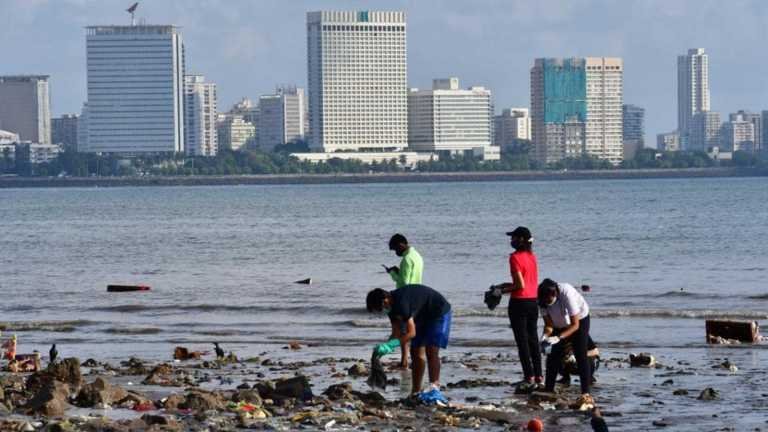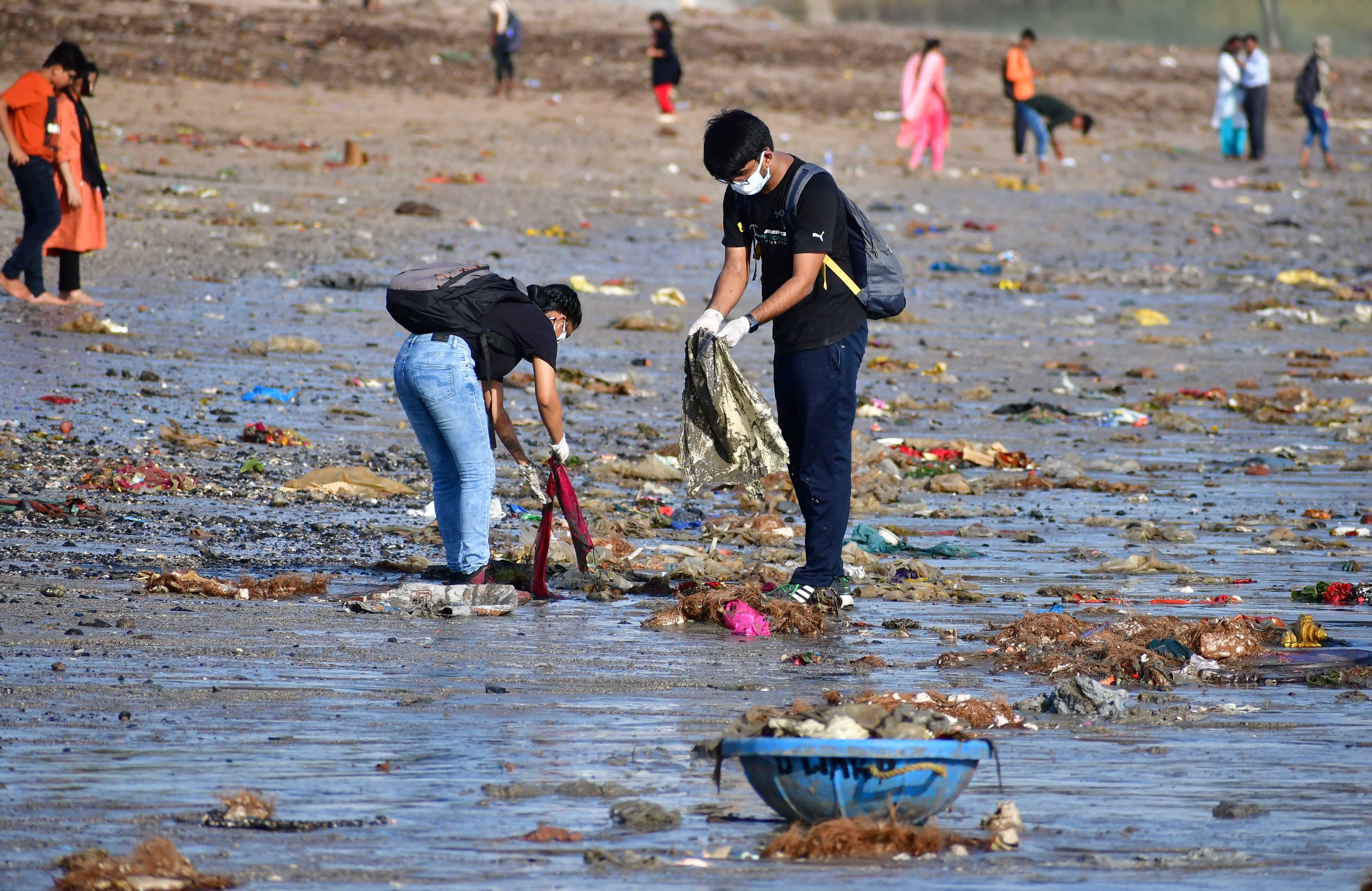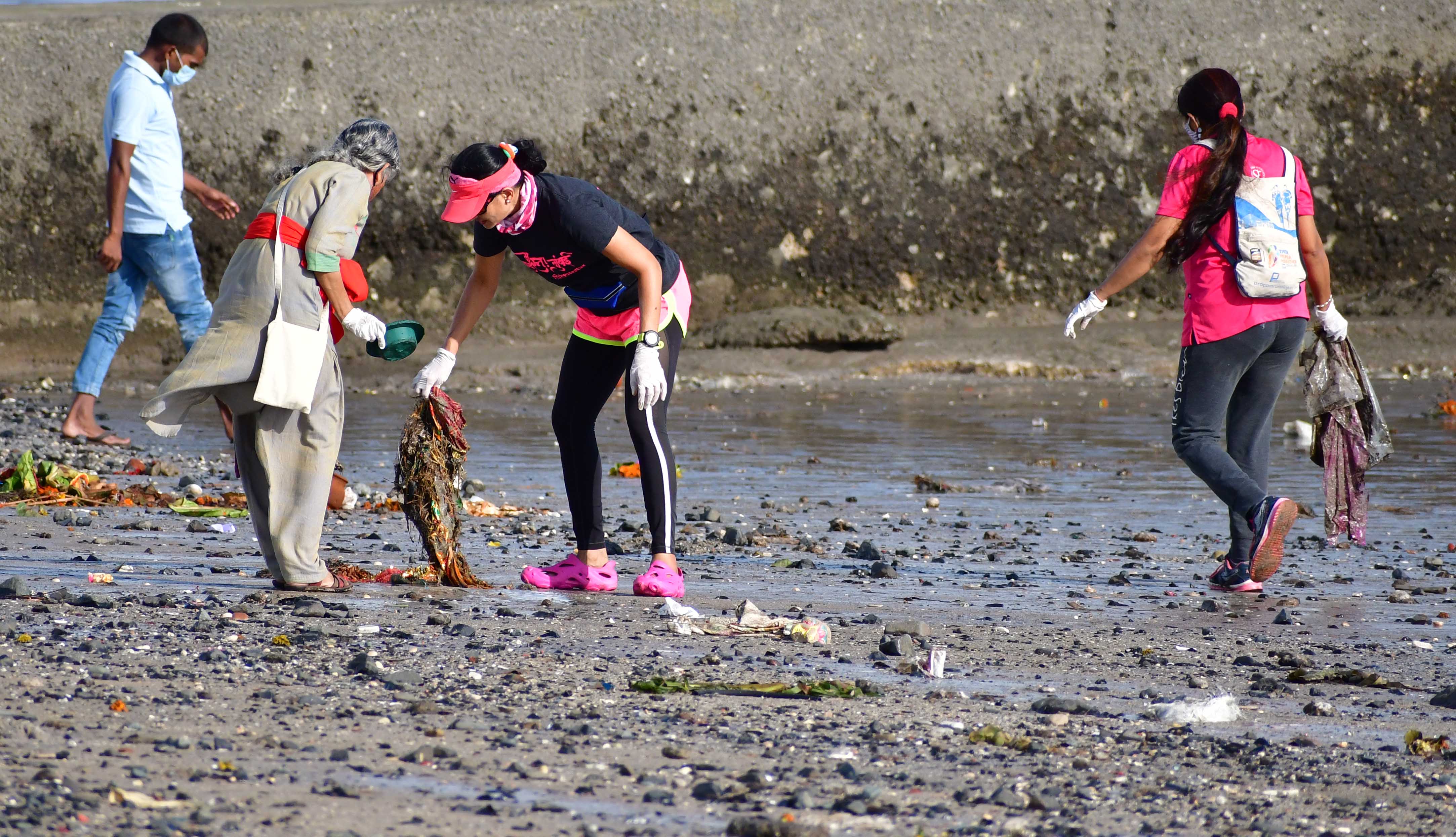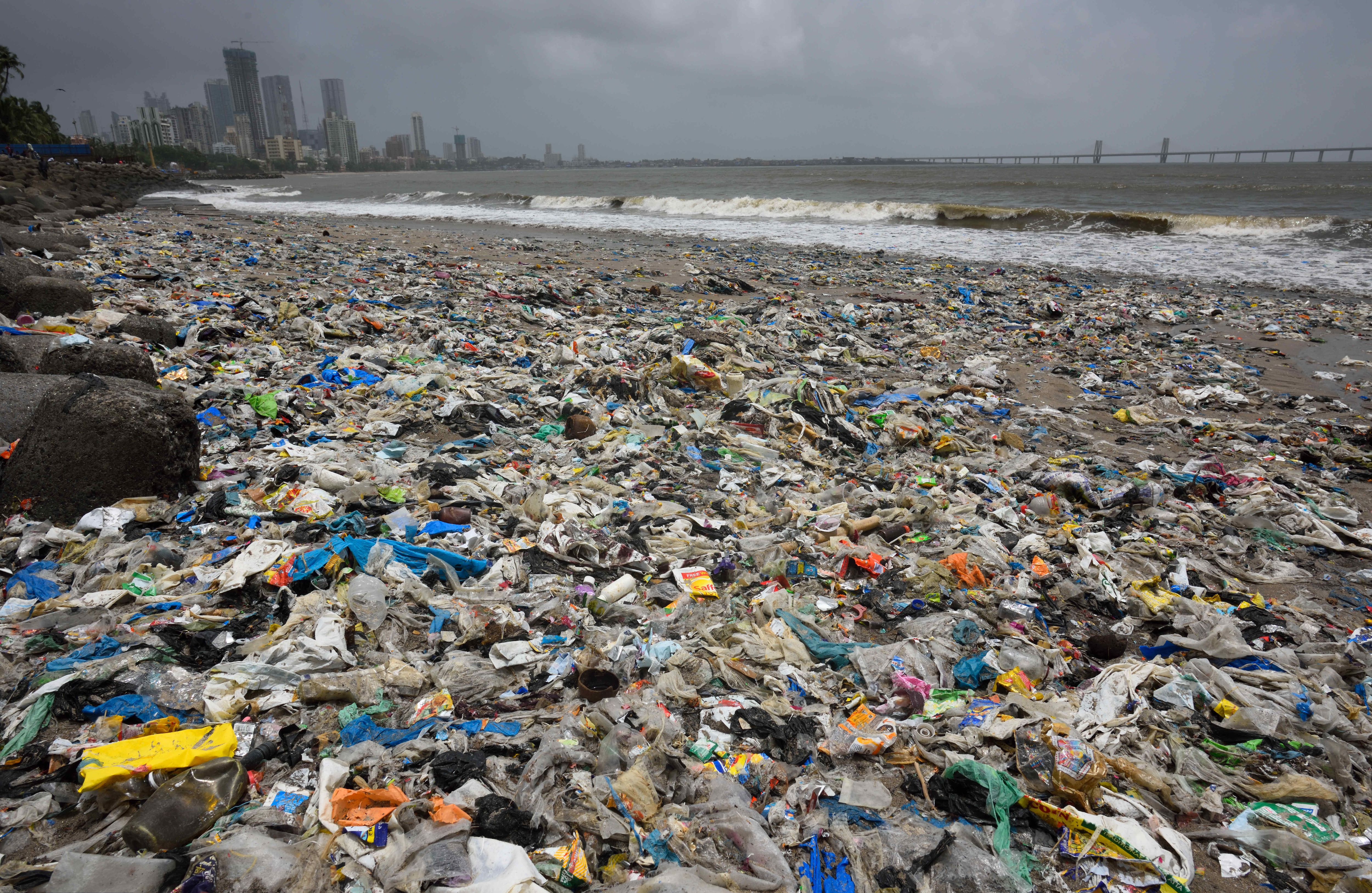
Between his work as a fisher hauling catch within the early hours of the day from August to October and a gig as a lifeguard with the Municipal Company of Higher Mumbai (MCGM), 26-year-old Sanjay Bamaniya, a resident of Sagar Kutir, Versova, has little time for enjoyable.
However, every time he can, he surfs. Properly-built and athletic, Bamaniya is a eager swimmer — he was a part of a civic physique operation that saved the lives of two boys who virtually drowned through the latest Ganesh Chaturthi visarjan close to Versova koliwada — and he has grown up with the ocean a strolling distance from his entrance door. When he hits the waves at Juhu and Versova seashores he’s undeterred by the air pollution and particles that Mumbai pours into the ocean daily, he stated.
“Browsing is unimaginable. Early on, I taught myself to drift on my abdomen utilizing giant sheets of thermocol and journey with the waves. About three or 4 years in the past I lastly acquired a surfboard and now I do it fairly frequently with a good friend,” he stated.
Had it not been for the big thermocol sheets floating round Versova seashore, Bamaniya would have by no means learnt to surf. However the irony isn’t misplaced on him – Thermocol is among the commonest plastic pollution in Mumbai’s shoreline and it poses a bigger risk to Bamaniya’s livelihood.
“Generally, at excessive tide throughout monsoon months, there’s a lot plastic floating on the water you may’t probably go swimming or browsing,” Bamaniya stated.
“When hauling fish, we find yourself with a number of kilos of plastic waste within the nets. It might take hours to segregate the waste from the catch earlier than going to market. We find yourself spending some huge cash and time fixing our nets; sharp bits of plastic can get tangled in them and even reduce them open,” he stated.

A sea of plastic
Thermocol, or expanded polystyrene (EPS), is certainly one of a number of forms of plastic that may be discovered alongside Mumbai’s shoreline. A latest analysis carried out by Helen White, an oceanographer at Haverford Faculty in Pennsylvania, United States of America, discovered that polystyrene comprised about 16% of plastic particles collected from three seashores of Mumbai: Juhu, Mahim, Ambojwadi in Malad.
Polyvinyl Chloride, or PVC — sometimes used to make drainage pipes, medical gadgets and insulation for energy cables amongst others — made up 40% of the particles. Polyethylene Terephthalate or PET — often present in meals and beverage packaging — made up 17%. Hint quantities of Polyvinyl Acetate (PVA; 1%), acetal (1%) and silicon (1%) — parts which have a variety of software as industrial adhesives and within the manufacture of client electronics — have been additionally discovered.
These outcomes are primarily based on evaluation of almost 1,200 plastic samples that have been collected at random from the above three places in Mumbai between 2018 and 2020. White introduced these findings as a part of a trans-disciplinary collaboration entitled Inhabited Seas, the place pure and social science researchers, architects and designers throughout the US and India studied numerous features of Mumbai’s city design within the context of its geographical location, as a coastal metropolis, and its rains.
That there’s a disaster isn’t new data. But it surely took one other catastrophic occasion to push this disaster into the limelight.
On Might 17, an Extraordinarily Extreme Cyclonic Storm with windspeeds between 150kmph and 160kmph made a landfall on the Gujarat coast leaving a path of destruction behind. Lakhs of individuals have been evacuated alongside the Konkan coast, and property value a number of lakhs was broken. Because the storm intensified over the times earlier than it made landfall, an lodging barge off the coast of Mumbai broke free and sank. One other tugboat received caught within the swirling waters and went below. The Indian Navy launched a search and rescue operation virtually instantly however at the least 88 of the 274 individuals couldn’t be rescued.
On June 30, the Bombay excessive courtroom expressed grave concern over one other aftermath of the cyclone. A bench comprising the Chief Justice Dipankar Datta and Justice Girish Kulkarni stated that a number of newspaper studies had pointed to the quantity of trash that the ocean had regurgitated on Mumbai’s seashores and promenades. These studies painted a “very sorry image with regard to the cleansing of the coast,” the bench noticed.
The Brihanmumbai Municipal Company (BMC) advised the courtroom that it had collected 153 metric tonnes (MT) of waste, largely plastic, from the town’s seven seashores the day after Tauktae handed Mumbai. That’s how a lot 51 elephants put collectively on a scale would weigh.
The precise quantum of the plastic polluting Mumbai’s shoreline, nonetheless, is tough to know.
In a paper printed by the Elsevier Journal Science of the Complete Surroundings in August final yr, a bunch of researchers from ICAR-Central Institute of Fisheries Schooling (CIFE) discovered that north-east Arabian Sea, simply off Mumbai, contained an estimated 379 MT of marine particles of which plastics contributed to 40.6% of the full by weight. The remainder consisted of various proportions of “steel, glass, rubber, wooden/paper, fabric/fibre and others (small degraded particles and pure particles like branches of a tree, coconut, and so on),” the paper said.
The researchers used a method referred to as swept space technique, the place the ocean is trawled at chosen sampling places to gather knowledge, which is then used to reach at a metric referred to as the imply catch per unit space or CPUA. The group carried out 25 trawls between September 2017 and Might 2018, gathering 1,107 objects of marine particles. Plastics objects comprised 87% of it. “Amongst this, plastic luggage and meals wrappers have been dominant,” the examine famous.
The imply CPUA of marine particles in Mumbai’s water was estimated at 22.4 kg per sq. kilometre of the ocean, although this technique has its limitations as small objects like bottle caps, free fibers and cigarette butts aren’t all the time caught in trawl nets. The researchers used this quantity to calculate the quantum of marine particles within the examine space — 379MT.

So what does this imply?
Martin Xavier, who works on the Fisheries Useful resource Harvest and Publish-harvest Administration Division at CIFE, and was one of many scientists concerned within the 25 trawls stated that the plastic to fish ratio is an estimated 1:17. “For 17kg of fish caught by a trawler off the Mumbai coast, a corresponding 1kg of plastic can also be inadvertently caught,” he stated.
“The presence of plastics isn’t just an environmental hazard, but additionally a well being hazard. Because the plastics stay within the surroundings, they grow to be a supply for microplastics which then discover their means into the meals chain and might bio-accumulate in people,” added Xavier.
In 2019, he led a examine that estimated that there have been 80 microplastic particles per 100 grams of fish, bivalves (clams, oysters) and shrimp, caught in Mumbai. Microplastics are small items of plastic lower than 5mm in size, which enter the surroundings from disposal and degradation of assorted client and industrial merchandise. Over time, giant items of plastic break off into tinier fragments below affect of wind, abrasion and publicity to UV mild. These could also be ingested by marine life, and transfer up the meals chain when people devour fish, for instance.
Research present their potential to disrupt the physique’s endocrine, reproductive and cardiovascular programs, along with probably carcinogenic influence. “It’s a critical concern as we discovered microplastic within the tissue, which is the edible half,” Xavier added.
It’s not simply the deep ocean that’s polluted. A 2013 examine led by researchers on the Nationwide Aquatic Assets Analysis and Improvement Company, Sri Lanka, discovered a imply abundance of 68.83 objects of plastic per sq. metre of land on 4 seashores in Mumbai: Dadar, Mahim, Juhu and Aksa.
A newer examine, printed in July this yr by researchers at CIFE discovered that plastics dominate the composition of marine particles in Mumbai’s mangrove forests, comprising 62% of all floor particles objects (by quantity) and 43 p.c (by weight) collected from Versova, Gorai, Bandra Bandstand, Sewri, Vikhroli and Elephanta Island.
Such empirical findings come as no shock to environmentalists and residents, a few of whom have stepped in to wash up. Certainly one of them is Afroz Shah, a lawyer and environmentalist who was credited with organising the world’s largest seashore up in Versova, in 2015, and has since saved up efforts at retaining the seashore clear.
“In seven years of organising seashore clear ups, we’ve collected a complete of 85,000 tonnes of plastic from simply two seashores, Versova and Danapani. Most of it’s plastic, and many of the plastic is meals wrappers and multi-layered packaging, or MLP. MLP is so conspicuous exactly as a result of it’s primarily unattainable to recycle, and the casual system of rag-pickers has no use for it,” Shah stated.
His workforce of volunteers now frequently segregates MLPs and sends them to a pyrolysis plant the place they’re was oil.
Up to now yr, within the midst of an unfolding disaster just like the Covid-19 pandemic, we’ve additionally added extra plastic to our day by day use: PPE kits, gloves, face shields, N95 masks.

Plastic, plastic in all places
Plastic sometimes enters the ocean by means of the town’s drainage channels and rivers, together with different pollution like sewage and industrial waste. One solution to cut back its ingress into the ocean would then be to wash these channels.
Beneath the Mithi River Rejuvenation pilot, the town bought a specialised machine for mechanical elimination of plastic waste (developed by Finland’s RiverRecycle venture; the MMRDA is overseeing the venture in affiliation with the worldwide Marine Particles Partnership). The machine is basically a floating barge with a mechanical barrier that segregates and extracts plastic waste and different particles from the water. It’s able to cleansing up about 50 tonnes of waste a day.
However consultants argue that that is hardly sufficient. An evaluation by the state mangrove cell throughout 14 places in 2019 discovered that greater than 50,000 tonnes of plastic was strewn in mangrove forests alone. Plastic rubbish and sewage is discovered within the different metropolis’s rivers too. In response to the Maharashtra Air pollution Management Board, the state itself produced over 300,000 tonnes of plastic waste within the yr 20-21 alone.
“A greater choice could be to put in grates on the sea finish of assorted outflows and have them cleaned frequently. This has been a requirement of environmentalists prior to now that we have now additionally recommended within the Excessive Courtroom, however the municipality has not proven any inclination towards contemplating it,” stated Stalin D, director of city-based NGO Vanashakti, which is at present pursuing litigation within the Supreme Courtroom to curtail air pollution of metropolis drains.
For these residing in closest proximity to this waste, like Bamaniya, the conspicuousness of plastics has grow to be simple to miss. “I do know it’s unhealthy for the surroundings, and that the fish eat it, however I actually don’t know what else to let you know,” he stated.
What’s fuelling the disaster?
On paper, Shah defined, India has a strong set of legal guidelines to cope with plastic waste, together with the Centre’s Stable Waste Administration Guidelines and Plastic Waste Administration Guidelines. In 2020, the Centre additionally got here up with a draft coverage referred to as the Prolonged Producer Duty (EPR), which makes producers chargeable for recycling an quantity of plastic equal to what they generate.
And whereas these guidelines clearly define pathways for assortment, segregation and recycling of plastic, they solely handle the issue of plastic as soon as it has was waste.
“Within the journey of plastic, it doesn’t begin out as waste. There may be what I name the pre-litter stage, when plastics exist on cabinets of shops and in our houses as objects of use. It’s solely once they fall out of use that they grow to be waste, and that transition is one thing that the legislation has not even begun to handle,” Shah stated.
What’s required as an alternative is what consultants name a round economic system of plastic, through which these supplies aren’t allowed to show into environmental contaminants.
“The EPR guidelines are supposed to handle this, however there are issues with it. For instance, a producer who produces 10kg of MLPs in a day isn’t really required to recycle the identical sort of plastic. He can simply as simply recycle 10kg of PET bottles, which have extra resale worth, and fulfill his duty. The legislation generalises the varieties of plastic, and leaves room for the worst form to grow to be pollution. Because of this we’re caught in a post-litter narrative, and why seashores must be continually cleaned,” Shah stated.
What’s extra, there isn’t any authorized mandate for the Maharashtra Air pollution Management Board to behave on plastic air pollution within the ocean. “The mandate of the MPCB is to control industries. Within the occasion that an industrial unit is discovered to be violating the Water Act, we revoke our clearances. However so far as the precise subject of plastic air pollution within the ocean is worried, there isn’t any authorized mandate for us to behave. Our job is to verify industries don’t pollute, and the BMC’s job is to maintain the seashore clear. The place the sand ends and water begins, there’s a lack of readability as to who’s accountable for the issue.”
HERE’S WHAT WE CAN DO
Restrict thickness of plastic carry luggage, ban manufacture of plastic lesser than 5 microns thick, section out single use plastic
Sanction the Prolonged Producer Duty (EPR) pointers which locations onus of recycling on the producers
Recycle extra. The state has the capability to recycle 365,236 tonnes each year in its 111 recycling models. In 2020-21, Maharashtra generated 311,254 tonnes of plastic; collected 251,556 tonnes of plastic waste; of that, despatched 23,237 tonnes to landfills and recycled 221,278 tonnes.
Give plastic an extended social life; create a round economic system
Sources: Plastic Waste Administration Guidelines and Stable Waste Administration Guidelines: Central Air pollution Management Board)
Quote 1: “Every time we obtain segregated waste from turbines, all of the parts together with plastic are correctly recycled. Air pollution occurs due to littering and lack of segregation at supply, which is as a lot a duty of residents as that of authorities. The Prolonged Producer Duty pointers, as soon as carried out, ought to have the ability to handle the present scenario. We’ve been working intently with the air pollution management board for sustainable waste administration and can proceed to take action.”
Minesh Damodar Pimple, deputy chief engineer within the BMC’s stable waste administration division
Quote 2: “A producer isn’t required to recycle the identical sort of plastic he produces. He can simply as simply recycle 10kg of PET bottles which have extra resale worth. The legislation generalises the varieties of plastic, and leaves room for the worst form to grow to be pollution”